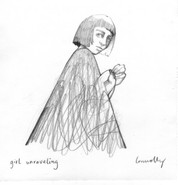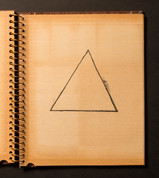Femininity and geometry are hardly new aesthetic themes in Caitlin Connolly’s artistic body of work. The triangle as both a symbol of and key visual component in depictions of women, girls, and the feminine draws on everyday iconographies (think stick figures and bathroom signs), pop culture (Weezer’s pink triangles), and feminist epic art (Judy Chicago’s The Dinner Party). In Connolly’s work triangles can be bodies and limbs, spatial arrangements, dresses and fabric patterns, facial structures. However formally deployed in composition, though, they invariably encode what is a central thematic preoccupation in her art: feminine expression and feminine identity.
Triangle Self rings with autobiographical intimacies. The work unmistakably tells us something about Connolly’s own navigation of the tensions, joys, pains, contradictions, and passions of contemporary feminine experience. Yet, the use of triangles—of a form so elemental and iconic—drives the visual compositions from the particular and individual out into the generic and universal. Here is depicted a woman; here is also depicted Woman. And despite the fact she is nowhere mentioned by name in the show, Eve’s presence looms grand. Eve is the feminine archetype, simultaneously a concrete, specific woman and Everywoman.
Girl With Space to Fall depicts a woman blown over, whose feet are nevertheless firmly planted in a projection of calm control. She has room to fall, is prepared and resigned. Her fall will not be the end of the world. It is doubtful that Connolly consciously referenced the Fall from Edenic grace here. Still, it is impossible not to see here the influence of Mormonism’s particular (and peculiar) rendering of Eve’s transgression: an eyes-wide-open, careful choice to embrace knowledge, to step into a fall from grace and accept the consequences, good and bad, to make the world rather than end it. Eve is heroic because she blesses the human family by accepting and embracing imperfection. Girl With Space does not depict Eve’s choice. But it cannot help but memorialize it.
The most overt rendering of Eve (though here she is also nameless, underscoring her generic universality) is in The Creation of Woman. The art book visually tells the story of woman’s creation from man’s rib in a way that channels not only the central visual theme of the show (the triangle) but also a crucial theme in Mormonism’s creation story. The triangle is as much the created woman’s body as it is her dress, with no visual cue for distinguishing the two. One is tempted to observe the superficial conflation of women’s identity with women’s attire, but in this case that misses the point entirely. Geometric symbols are a crucial part of how Mormons ritually memorialize creation, yet the deeper point here is that our account of creation includes the provision of clothing. Just as one body is the extension of the other, so are the sewn clothes an extension of the created bodies. Creation is complete when woman and her partner leave the presence of their Heavenly Parents with clothing that marks them as children of the divine.















































